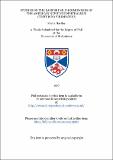Files in this item
Studies on the lampbrush chromosomes of the American newt notophthalmus (triturus) viridescens
Item metadata
| dc.contributor.advisor | Callan, Harold Garnet | |
| dc.contributor.author | Hartley, Sheila | |
| dc.coverage.spatial | ii, 61 p. | en_US |
| dc.date.accessioned | 2018-06-12T14:07:35Z | |
| dc.date.available | 2018-06-12T14:07:35Z | |
| dc.date.issued | 1977 | |
| dc.identifier.uri | https://hdl.handle.net/10023/13962 | |
| dc.description.abstract | Observations have been carried out on the lampbrush chromosomes of Notophthalmus (Triturus) viridescens, the American newt; especially of chromosome II and XI. Chromosome II regularly bears two and occasionally three pairs of giant loops situated close to the centromere, The giant loops are distinguished from the majority of the normal loops by the greater bulk of their matrix and their length, which may vary from 60 mum to 300 mum. The giant loops are usually observed aa single loop pairs arising from a single chromomere but occasionally they occur as multiple loop pairs from a single chromomere. The giant loops also show variation in the distribution of their RNP matrix and more than one polarized matrix unit may be present on a single loop. The size of the loops and the matrix distribution pattern around any one loop pair is constant in oocytes ranging in size in any particular animal. The effect of increasing and decreasing the metabolic rate of the newt, by using hormone injections and cold treatment respectively, on the length and matrix distribution patterns of the giant loops was investigated. Hormone injections may cause changes in loop length, usually an increase but in one case a decrease, or have no effect. This may be due to the initial loop length or the level of gonadotrophin already present in the animal. After hormone injections the matrix distribution pattern, in multipolarized loops, alters with an increase in the proportion of the loop occupied by the first matrix unit. The constancy of loop characteristics over a range of oocyte sizes and the effect of hormone treatment are discussed in terms of matrix roving round a stationary loop axis. Cold treatment causes a dramatic shortening of the majority of lateral loops but leaves the giant loops virtually unaltered. Autoradiographic experiments have shown that the rate of RNA synthesis in the giant loops is half the rate of synthesis on the ordinary loops and that the RNA transcribed by the giant loops contains very little guanine. These results are discussed in terms of differing rates of RNA polymerase movement or attachment, different types of RNA polymerase molecules and the organization of highly repetitive sequences in the genome. The effect of inversion heterozygosity on chiasma distribution in bivalent XI was also studied, 15 out of 94 females studied were heterozygous for an inversion involving almost the whole of the longer arm of bivalent XI and including' the sequentially labelling loops situated close to the end which are transferred, by the inversion, to a position close to the centromere. The chiasma distribution in normal bivalents XI was compared with that of normal bivalents II and inversion heterozygote bivalents XI. Normal bivalents XI have chiasmata restricted to the chromosome ends while normal bivalents II have unrestricted distribution of chiasmata. In inversion heterozygote bivalents XI no chiasmata at all are formed in the longer inverted arm pair and chiasmata become distributed throughout the length of the shorter non-inverted am pair. Chiasma distribution was found to be similar in both sexes. These results are discussed in terms of the availability of recombination nodules and the time of their association with the synaptonemal complex. | en_US |
| dc.language.iso | en | en_US |
| dc.publisher | University of St Andrews | |
| dc.subject.lcc | QH600.H2 | en |
| dc.subject.lcsh | Chromosomes | en |
| dc.title | Studies on the lampbrush chromosomes of the American newt notophthalmus (triturus) viridescens | en_US |
| dc.type | Thesis | en_US |
| dc.contributor.sponsor | Science Research Council (Great Britain) | en_US |
| dc.type.qualificationlevel | Doctoral | en_US |
| dc.type.qualificationname | PhD Doctor of Philosophy | en_US |
| dc.publisher.institution | The University of St Andrews | en_US |
This item appears in the following Collection(s)
Items in the St Andrews Research Repository are protected by copyright, with all rights reserved, unless otherwise indicated.

